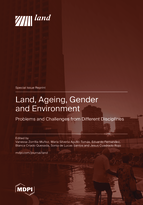Land, Ageing, Gender and Environment: Problems and Challenges from Different Disciplines
A special issue of Land (ISSN 2073-445X). This special issue belongs to the section "Urban Contexts and Urban-Rural Interactions".
Deadline for manuscript submissions: closed (31 August 2022) | Viewed by 38950
Special Issue Editors
Interests: ageing and old age; gender; land; rural development; emerging technologies; climate change and emissions; health; social psychology and sociology
Special Issues, Collections and Topics in MDPI journals
Interests: ageing and old age; land/environment; gender and feminism; habitat/rural spaces; evaluation of programmes; caring/work; climate/social change; health; technologies; social psychology and sociology
Special Issues, Collections and Topics in MDPI journals
Interests: health in land; emerging technologies and interfaces related to rural development and land; ageing and old age in land; biomedical engineering; bioengineering and neuroscience
Special Issues, Collections and Topics in MDPI journals
Interests: ageing and old age; gender; evaluation of programmes; labour relations; employment in land; sociology
Interests: environment and emissions; applied economics and public policies in land; circular economy; advanced statistics; business cycles in land; convergence and sustainability
Special Issues, Collections and Topics in MDPI journals
Interests: environment and emisssions; circular economy; construction and building in land; forest certification; sustainability and climate change
Special Issues, Collections and Topics in MDPI journals
Special Issue Information
Dear Colleagues,
Recent studies argue that we are facing a silent and not so novel socio-environmental crisis. This proposal is based on the evidence and confirms the need to continue the evaluation and research in several key aspects of land, from different approaches and disciplines. I.e. there are some references linked to land and gender, but there are fewer researches about older people and green societies. Therefore, the main aim of this Special Issue - in the context of some Sustainable Development Goals (SDGs) - is to bring together researchers from different fields and open a dialogue regarding some gaps of the land, including ageing and gender relationships. The current Special Issue is open to submission of previously unpublished work on all aspects of the land, focused on the following:
- Land and environment from sociological, health, psychological, political, technological, economic, communication and engineering sciences.
- Active ageing and dependent old age, i.e. studies on older people role in relation to environment, accessibility and usability, social image and attitudes, with special reference to older women.
- Gender studies regarding environmental issues, land; green economy impacts and different social-spatial habitats (rural-intermediate-urban and residential environment) which favor inclusion, and reflect from feminist and non-ageism perspective.
- Differences or comparison of population, i.e. related to gender, feminisms (ecofeminism, etc.) and intergenerational approach, among others.
- Evaluation of programs and initiatives at different levels (education, health, climate change and social climate action, technology, work, leisure, circular economy…), whose purpose is related with reducing ageism and the gap between the land and older people and/or to promote sustainable development and public policies.
- Socio-health addressing land interactions and impacts on health (physical and psychosocial), circular economy and quality of life, from generational, gender perspective and/or in the current context of COVID-19 pandemic.
- Images, stereotypes and attitudes from the different socio-political agents – population, education, employment, mass media, etc. – around any mentioned area, mainly the relationship between environment, land, ageing and gender.
- New technologies and technological and economic approaches contribute to land, reduction of emissions/water consumption and the improvement of environmental management, sustainable construction and buildings, among others. This includes emerging technologies such as agriculture machinery, use of robots, vertical farming, culture meat, artificial brain and intelligence applied to land.
Dr. Vanessa Zorrilla-Muñoz
Prof. Dr. Maria Silveria Agulló-Tomás
Prof. Dr. Eduardo Fernandez
Dr. Blanca Criado Quesada
Prof. Dr. Sonia de Lucas Santos
Prof. Dr. Jesus Cuadrado Rojo
Guest Editors
Manuscript Submission Information
Manuscripts should be submitted online at www.mdpi.com by registering and logging in to this website. Once you are registered, click here to go to the submission form. Manuscripts can be submitted until the deadline. All submissions that pass pre-check are peer-reviewed. Accepted papers will be published continuously in the journal (as soon as accepted) and will be listed together on the special issue website. Research articles, review articles as well as short communications are invited. For planned papers, a title and short abstract (about 100 words) can be sent to the Editorial Office for announcement on this website.
Submitted manuscripts should not have been published previously, nor be under consideration for publication elsewhere (except conference proceedings papers). All manuscripts are thoroughly refereed through a single-blind peer-review process. A guide for authors and other relevant information for submission of manuscripts is available on the Instructions for Authors page. Land is an international peer-reviewed open access monthly journal published by MDPI.
Please visit the Instructions for Authors page before submitting a manuscript. The Article Processing Charge (APC) for publication in this open access journal is 2600 CHF (Swiss Francs). Submitted papers should be well formatted and use good English. Authors may use MDPI's English editing service prior to publication or during author revisions.
Keywords
- land/environment/ecology
- ageing/ageism/older people
- gender/eco/feminisms
- evaluation of programmes
- health, social services and education
- economic and public policies
- work/employment and leisure/tourism
- images/stereotypes
- rural-urban spaces/frames
- social and technical sciences
- pandemic, psico-social crisis and climate change











